Alaska Native vision for the future: Self determination
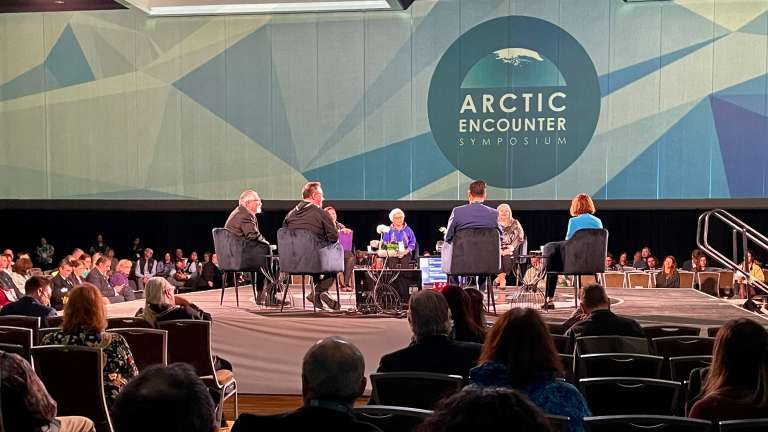
A panel on "Northern Indigenous Leadership: Our Future, Our Vision for Success," is held at the Arctic Encounter Symposium on April 10, 2024, in Anchorage. (Photo by Joaqlin Estus/ICT)
ANCHORAGE, Alaska — Indigenous leaders want a seat at the table and to be seen and heard. “Nothing about us without us.”
That’s the message Indigenous leaders shared at an Arctic symposium that organizers say brought in participants from 30 countries. Six Inupiaq, Tlingit and Athabascan leaders kicked off “Arctic Encounter 2024” with a plenary session entitled “Northern Indigenous Leadership: Our Future, Our Vision for Success.” Organizers say the three-day symposium drew about a thousand leaders in diplomacy, research, science, the military and business to the Dena’ina Convention Center in Anchorage.
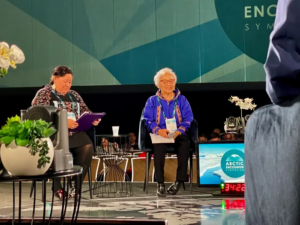
Dr. Pearl Kiyawn Nageak Brower, Inupiaq, is CEO of Ukpeagvik Inupiat Corporation and Affiliate Research Professor at the International Arctic Research Center, and at right is Kasannaaluk Marie Green, Inupiaq, speaking at the Arctic Encounter Symposium on April 10, 2024, Anchorage, Alaska (Photo by Joaqlin Estus/ICT)
Kasannaaluk Marie Greene, Inupiaq, is president of the Inuit Circumpolar Council, which is made up of members from Greenland, Canada, Russia and the United States. She told an audience of about 150 people her goal is to continue to fulfill the vision of the council’s founder, Eben Hopson, Inupiaq: “to have our Inupiat people at the international level come together to strengthen our unity, to work together in harmony as we come together and address our concerns, our common concerns, our challenges, and what we need to be doing going forward as we continue to build that unity.”
Greene said Hopson expressed at the founding meeting of ICC in 1977 “the need to … to be promoting our language, our culture, our customers, who we are as Inuit and to promote and work with our governments, to ensure that we have the policies, long-term policies in place and to also address our interests at the international level.”
She added that Hopson challenged “us to do what we can to protect our homeland, to protect the Arctic and that’s a privilege being in this role that I have.”
She said communications need to be honest and respectful toward governments, but “we have got to be expressing our concerns about the change of the climate that we’re now experiencing in the Arctic.”
Apagzuk Roy Agloinga, Inupiaq, is president and CEO of the First Alaskans Institute, an Alaska Native policy and advocacy nonprofit. “(Our) people have always lived in this land,” he said. “We have a passionate and deep connection to every place. And the fact that we are able to make decisions about education, about the economy, about any kind of policy that impacts us, is really critical.”
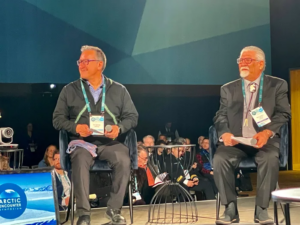
At left, Apagzuk Roy Agloinga, Inupiat, is president and CEO of the First Alaskans Institute, an Alaska Native policy and advocacy nonprofit with at right, Morrie Lemen, Jr., Tlingit, is executive director of the federally recognized tribe, the Inupiat Community of the Arctic Slope. They spoke at the Arctic Encounter Symposium on April 10, 2024, in Anchorage. (Photo by Joaqlin Estus/ICT)
Agloinga said the institute plans to build on the training and education previous First Alaskans leaders have provided on the importance of subsistence, an effort he said that helped lead to the appointment of three subsistence users to the federal Subsistence Board. “One of the things that we’ve done, of course, is a lot of advocacy around protecting our ways of life and have such an amazing working group with about 200 people who are from across the state.” That work was brought to the forefront, he said, “so that we can really work closely with our communities to identify ways so that they can continue protecting subsistence… that will always continue to be a major priority for us, and we want to make sure that our community understands what the issues are and how to move forward.”
Agloinga said youth leadership is also a key area for the Institute. “Our youth are pretty amazing and the youth that participated in (our) Elders and Youth conference really already show tremendous leadership in their region. We want to make sure that those young people are able to get as much support as they can, as much education as they can, as much knowledge as they can about the issues that are so important to us as Native people in Alaska so that they can continue the fight for self-determination and really understand what that means.”
Aaron Schutt, Koyukon Athabascan, is CEO of the Alaska Native regional corporation Doyon Limited. He told the audience the Doyon region is about the size of the country of France, and home to about 40 communities, and 25 village corporations. Doyon has about 20,500 shareholders.
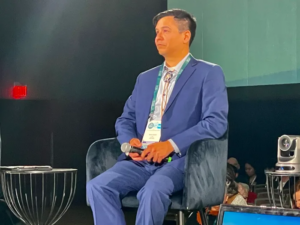
Aaron Schutt, Koyukon Athabascan, is CEO of the Alaska Native regional corporation Doyon Limited. He spoke at the Arctic Encounter Symposium on April 10, 2024. (Photo by Joaqlin Estus/ICT).
“We were able to select and retain about 12.2 million acres within our very large homeland,” Schutt said. “We share about 4 million of those acres with our village corporations where they own the surface and we own the subsurface and we have about 8.2 million acres that we own outright like all the other Native companies. Our job is to make money, train and employ our shareholders, and then, most importantly, steward our land base.
“We have our land. We have our people. We have to have economic success in order for our people to thrive, in order for us to steward the land. The federal government doesn’t give us any money…We have trespass, fire, gravel, wildlife, all these issues that are very important to our people, that we have economic success in order to take on all of those issues.” He quoted a former chief who would often say, “We’re doing well; we can do better.”
Dr. Pearl Kiyawn Nageak Brower, Inupiaq, is president/CEO of the Ukpeagvik Inupiat Corporation, and Affiliate Research Professor at the International Arctic Research Center. She said like the other village, urban and regional corporations created under the Alaska Native Claims Settlement Act of 1971, Ukpeagvik Inupiat Corp represents a distinct Alaska Native community village tribe. ”But each has an important land base and each has had to learn how to traverse the for-profit environment.”
The Ukpeagvik corporation has about 3,800 shareholders and stewards about 229,000 acres of ancestral lands. “We employ about 4,700 people and about a quarter of those are here in Alaska,” Brower said. “We are the ninth largest company by revenue in the state and we’re hoping to be the eighth after the end of this year. So our mission is really we bring our Inupiaq values to the services and products that we provide to enhance the lives of our shareholders.”
She said of shareholders, “They’re us. They’re our aunts and our uncles, they’re our grandparents, they’re our parents, they’re our children, our grandchildren, and what that looks like into the future. I think we also have challenges in the market and in policy. Nothing about us without us is just how we have to move forward.”
Brower added, “I think as Indigenous people, right, we are the best ecologists. We are the best scientists for our region. We are tethered to our place. We care about our land. We want it to be there for future generations…listen to the people, listen to those who have lived off this land and learned the stories and heard the stories and been taught about this place for generations.
Morrie Lemen, Jr., Tlingit, is executive director of the federally recognized tribe, the Inupiat Community of the Arctic Slope. He said the Alaska Native Claims Settlement Act was a dramatically different approach to federal Indian policy. “It created a fragmented system of the Alaska Native representation and delivery of services that required a coordinated approach to effectively serve Alaska Native people. It also resulted in landless groups, which ICAS is one of.”
Speaking of his vision of success, he said “The first thing that comes to my mind is self-determination. We determine our future by building our own, growing our own leaders based on millennia of tradition. Listen to us. I challenge the audience every time you think about the Arctic, think about the people first. What we have identified as our needs, not what you think we need. The North Slope approach to leadership is centered at the local level. There’s a trust that the residents of our villages know what is best for their village and we support them, not supplant them. At ICAS, we work to uplift, empower, and grow the tribes and our tribal citizens within our region.”
Tara Katuk Mac Lean Sweeney, Inupiaq, is vice president for external affairs, at ConocoPhillips Alaska, an oil company that has had a presence in Alaska she said for 50 years, “and we continue in our commitment to the state.”
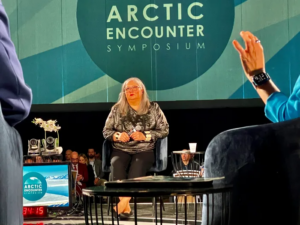
Tara Katuk Mac Lean Sweeney, Inupiaq, vice president for external affairs at ConocoPhillips Alaska, spoke at the Arctic Encounter Symposium on April 10, 2024, in Anchorage. (Photo by Joaqlin Estus/ICT)
She said life has changed in Alaska over the years. “I grew up on the cusp of development and was 16 when we finally had the infrastructure to have a flush toilet in our home. And there are many communities throughout Alaska that still don’t have the infrastructure to afford that luxury, and it’s important to remember. But what development has provided to Indigenous communities across the North Slope is opportunity, opportunity for education, opportunity to live in thriving communities that have police and fire protection, opportunities for work and career, career advancement.
“So our goal and our focus at ConocoPhillips really is to develop Alaska resources safely and responsibly and responsibly really means a number of things: Effective stakeholder engagement. It also means transparency and respect in the process. But effective stakeholder engagement means that local voices have a seat at the table, that they help guide the process, the projects through the conception phase all the way to the production phase. And so for me, when you ask me what success looks like, that would be my answer.”
The three-day conference continued with sessions ranging from energy, governance, and wildfire management, to oil spill response, security, and waste management, as well as media, leadership, thawing permafrost, food security, science, education, health, shipping, and geopolitics.
ICT originally published this article. ICT is an an independent, nonprofit, multimedia news enterprise. ICT covers Indigenous peoples.
The post Alaska Native vision for the future: Self determination appeared first on Alaska Beacon.
